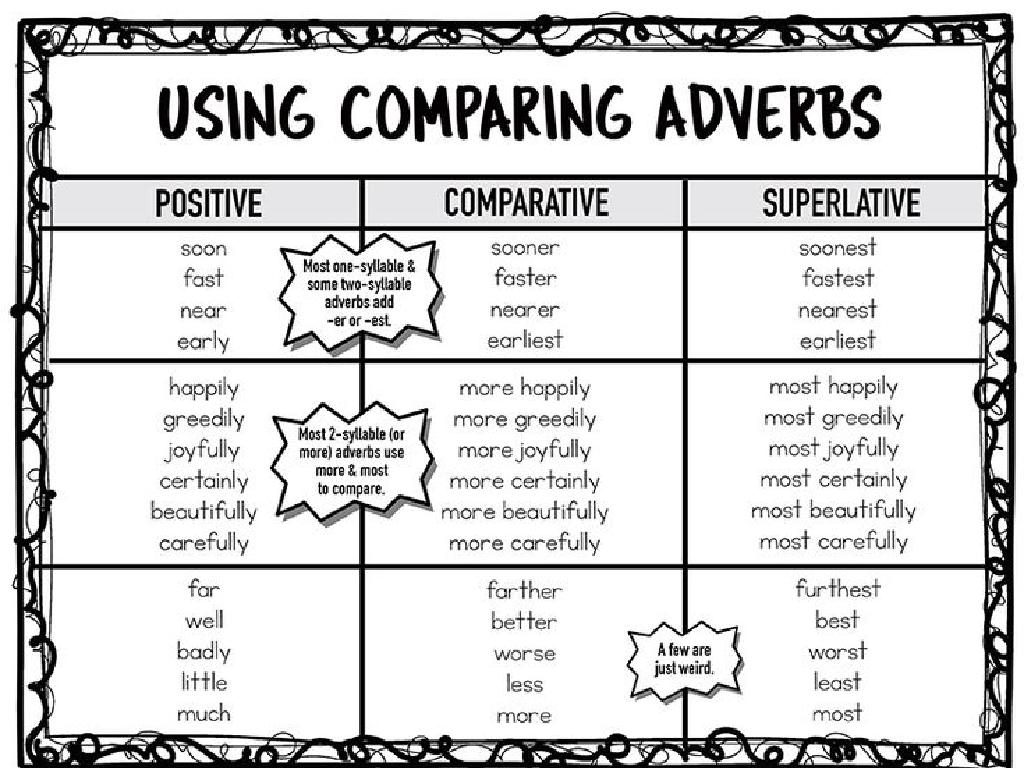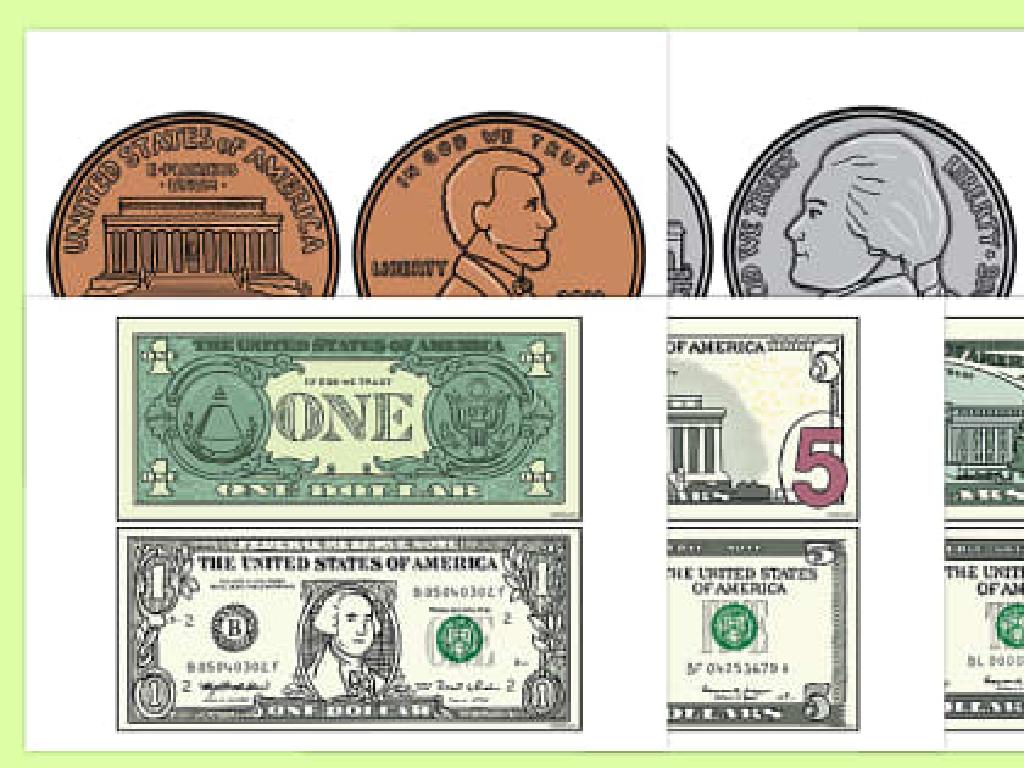Add Multiples Of 10
Subject: Math
Grade: Second grade
Topic: Addition: Two Digits
Please LOG IN to download the presentation. Access is available to registered users only.
View More Content
Adding Multiples of 10
– Greet our bright young learners
– Adding numbers with zeros
– Numbers like 10, 20, 30 have one zero
– Multiples of 10 are special
– 10, 20, 30 are all multiples of 10
– Big number addition made easy
– Learn to quickly add 10, 20, 30 to other numbers
|
Begin the lesson with a warm welcome to engage the students and create a positive learning environment. Explain that today’s focus will be on understanding how to add numbers that have zeros at the end, which are known as multiples of 10. Emphasize that this skill is important as it simplifies the process of adding larger numbers. Use visual aids like number lines or base-ten blocks to demonstrate the concept. Provide examples such as 10+20, 30+40, and so on. Encourage students to notice patterns when adding multiples of 10 and reassure them that this will make math with big numbers much easier.
Understanding Multiples of 10
– What are multiples of 10?
– Numbers like 10, 20, 30, etc.
– Recognizing multiples of 10
– They always end with a zero
– Examples of multiples of 10
– 10, 20, 30, 40, 50…
– Class activity: Identify multiples
– Can you find two multiples of 10?
|
This slide introduces the concept of multiples of 10 to second-grade students. Begin by explaining that multiples of 10 are numbers that can be counted by tens. Emphasize that these numbers always end with a zero, which makes them easy to recognize. Provide clear examples like 10, 20, 30, and so on, and write them on the board if possible. For the class activity, ask students to identify two multiples of 10 either from the examples provided or from their own understanding. This will help assess their grasp of the concept and encourage participation. Offer guidance and positive reinforcement as they learn to identify these numbers.
Visualizing Multiples of 10 with Ten Frames
– Count by tens using ten frames
– Ten frames help us see numbers visually
– Full frame equals 10 dots
– Imagine each frame filled with 10 dots
– Counting 10, 20, 30 made simple
– It’s like stacking blocks in groups of 10
– Practice adding multiples of 10
|
This slide is designed to help second graders visualize and understand the concept of counting by tens, which is a foundational skill in understanding place value and addition of two-digit numbers. Ten frames are a great visual aid for this purpose. Each ten frame represents a group of 10, and by filling the frames with dots, students can easily see and count by tens. Encourage the students to draw their own ten frames and fill them with dots to practice. This will also prepare them for adding multiples of 10, as they will be able to visualize the addition process. For example, 10 (one full frame) plus 20 (two full frames) equals 30 (three full frames).
Adding Multiples of 10
– Add in the tens place only
– When adding 10s, like 20, 30, or 40, just add the first number.
– Ones place remains unchanged
– Since we’re adding 0s, the number in the ones place doesn’t change.
– Example: Adding 20 + 30
– Let’s add 20 and 30. What’s 2 tens plus 3 tens?
|
This slide introduces the concept of adding multiples of 10, which is a foundational skill in understanding place value and addition within the base-ten number system. Emphasize to students that when adding multiples of 10, they only need to focus on the tens place, as the ones place will not be affected by the addition of zero. Use the example 20 + 30 to illustrate this point, and encourage students to think of the numbers as groups of tens to simplify the process. After explaining, ask students to try a few examples on their own, such as 40 + 20 or 50 + 30, to reinforce the concept.
Practice Time: Adding Multiples of 10
– Try adding multiples of 10
– Focus on the tens place
– The number in the tens place goes up by 1 for every 10 added
– Solve problems together
– Example: 20 + 30. Add the tens: 2 tens + 3 tens = 5 tens, which is 50
– Practice makes perfect
|
This slide is designed to engage students in hands-on practice with adding multiples of 10. Encourage the students to concentrate on the tens place as that’s where the addition will occur. Start by solving a couple of problems as a class on the board, guiding them through the process. For example, with 20 + 30, show them how to add the 2 tens and 3 tens to make 5 tens, which equals 50. Then, let the students try similar problems on their own or in small groups. Provide immediate feedback and support as needed. The goal is to build their confidence and understanding of the concept through repetition and practice.
Adding Multiples of 10 with a Number Line
– Use a number line for adding
– Jump in tens on the line
Like hopscotch, but with jumps of 10
– Example: 10 to 30
Start at 10, hop twice to land on 30
– Practice with different numbers
Try starting at different numbers
|
This slide introduces the concept of using a number line to add multiples of 10, which is a visual and interactive method suitable for second graders. Explain that a number line is like a ruler that helps us count and add numbers. Demonstrate how to make ‘jumps’ or ‘hops’ on the number line in increments of 10 to add numbers together. Use the example provided to show how starting at 10 and making two jumps of 10 lands us at 30. Encourage students to practice this technique with different starting points and multiples of 10 to reinforce the concept. This activity can be turned into a fun classroom game where students draw their own number lines and show their jumps to the class.
Let’s Play a Game: Adding Tens!
– We’re playing a tens addition game
– Roll the dice for your number
– If you roll a 3, you move 30 spaces
– Move that many tens on the board
– First to 100 is the winner!
|
This interactive game is designed to help second graders practice adding multiples of 10 in a fun and engaging way. Set up a game board with spaces numbered from 0 to 100 in increments of 10. Provide dice for the students to roll. When a student rolls a number, they move forward that many tens on the board (e.g., rolling a 4 means moving forward 40 spaces). The goal is to reach 100. For the teacher: Prepare a large game board on the floor or a poster, and have a dice and game pieces ready. Consider variations of the game for different skill levels, such as using two dice for advanced students or creating obstacles on the board for an additional challenge. This activity will reinforce the concept of skip counting by tens and the addition of two-digit numbers.
Class Activity: Grouping Tens
– Form groups and gather blocks
– Make groups of 10 with blocks
Each group of blocks represents 10 units
– Add the groups to find totals
If you have 3 groups, you have 30 units in total
– Share your totals with the class
|
This activity is designed to help students understand the concept of grouping in tens to simplify addition. Provide each group with a set of blocks or counters. Instruct them to create groups of 10 and then add these groups together. This hands-on activity will reinforce their understanding of multiples of 10 and addition. After the activity, facilitate a discussion where each group shares their process and results. This will encourage collaborative learning and help students articulate their understanding of the concept. Possible variations for different groups could include using different numbers of blocks, starting with a preset number of groups, or challenging them to reach a specific total.
Conclusion: Mastering Multiples of 10
– Excellent work with multiples of 10
– Focus on the tens place
– The tens place determines the multiple of 10
– Practice is key to perfection
– Regular practice will help you improve
– Continue practicing at home
|
Today’s lesson was focused on adding multiples of 10, which is an important skill in understanding place value and addition. Reinforce the concept that when adding multiples of 10, the tens place is what changes, while the ones place remains the same. Encourage students to practice this skill at home to become more confident and proficient. Provide them with additional worksheets or suggest fun activities like adding the scores in a game to reinforce their learning. Remember to praise their efforts and progress to keep them motivated.






